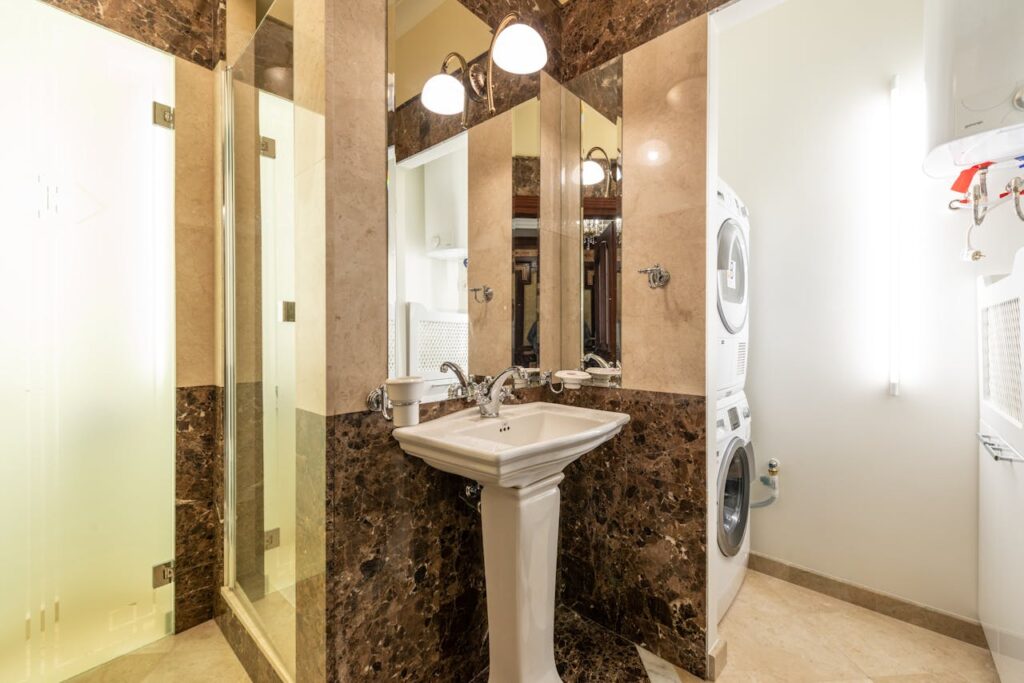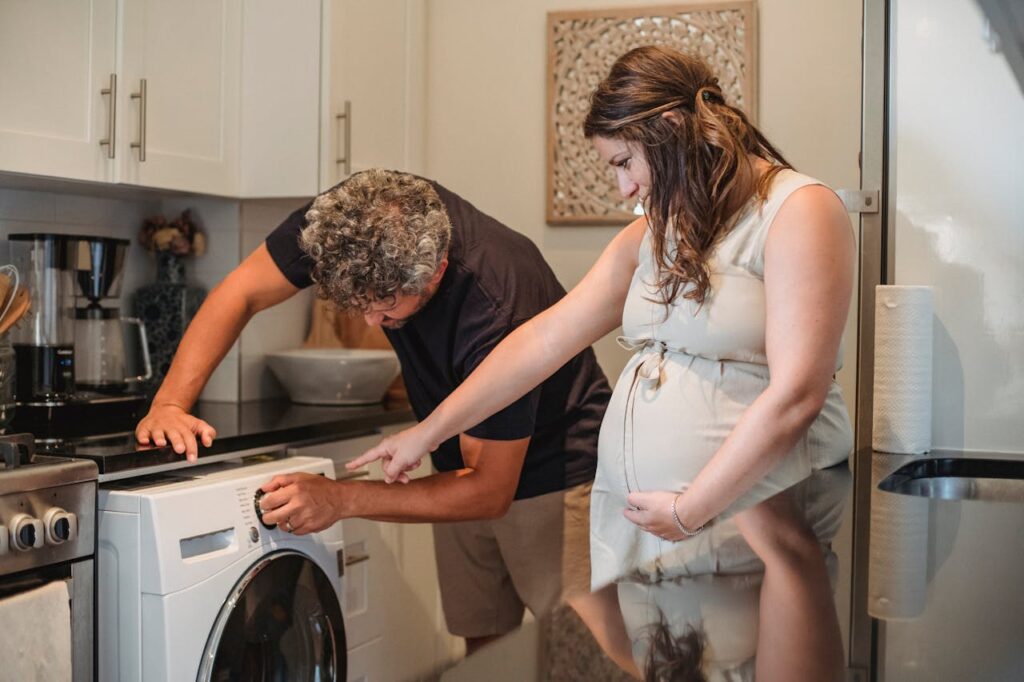Have you ever wished your laundry area was a little more organized and hidden away? Maybe your laundry room takes up too much space or just feels cluttered.
Turning a closet into a laundry nook can be a smart and simple solution! A laundry nook fits into small spaces, keeps things neat, and makes laundry time easier.
Read on to find out how you can convert a closet into a laundry nook. We’ll talk about what you need, how to plan the space, and some easy steps to follow. By the end, you’ll see that you don’t need a big room to have a great laundry spot!
Key Takeaways
- Use existing space smartly by turning a closet into a laundry nook to save room.
- Plan your layout carefully to fit laundry machines, storage, and workspace.
- Add shelves or hooks to keep detergent, baskets, and tools organized.
- Make sure there’s good ventilation to prevent moisture and keep things fresh.
- Keep the space tidy and accessible for a smoother laundry experience every time.
What Is a Laundry Nook?
A laundry nook is a small, dedicated space in your home where you do your laundry. It usually includes a washer and dryer, some storage for detergents and cleaning supplies, and sometimes a little counter or area to fold clothes.
Unlike a full laundry room, which can be large and separate, a laundry nook fits into a smaller spot. It can be in a corner, part of a hallway, or—most often—a closet. The goal is to have everything you need for laundry in one compact, easy-to-use area.
For example, imagine a small closet with a stacked washer and dryer, a shelf above to hold detergent bottles, and a few hooks on the wall for cloth bags or cleaning brushes. That’s a laundry nook! It helps keep your laundry tasks organized without taking up too much space.
Why Convert a Closet Into a Laundry Nook?
Converting a closet into a laundry nook can make your home better in several ways.
Here are some reasons why it’s a smart choice:
1. Saves Space
Many homes don’t have a lot of extra room for laundry. Closets are often empty or just hold things you don’t use every day. Turning a closet into a laundry nook uses space you already have. This frees up other rooms for living, working, or playing.
2. Keeps Laundry Hidden
Laundry rooms can look messy, with piles of clothes, baskets, and cleaning supplies. When you put laundry machines in a closet, you can close the doors to hide the mess. This keeps your home looking neat and clean.
3. Makes Laundry More Convenient
Having your washer and dryer close to where you live or sleep saves time. Instead of going to a basement or garage, your laundry nook is right where you need it. This can make laundry feel less like a big chore.
4. Can Be Customized to Your Needs
Closets come in different shapes and sizes. You can add shelves, hooks, or even a small folding area to fit your habits. For example, if you like to keep your laundry detergent bottles in one place, you can install shelves at the right height.
5. Improves Home Value
If you ever sell your home, having a smart laundry space can be a plus. Many buyers like having laundry close to living spaces. A well-designed laundry nook shows you used your space wisely, which adds appeal.
How to Convert a Closet Into a Laundry Nook
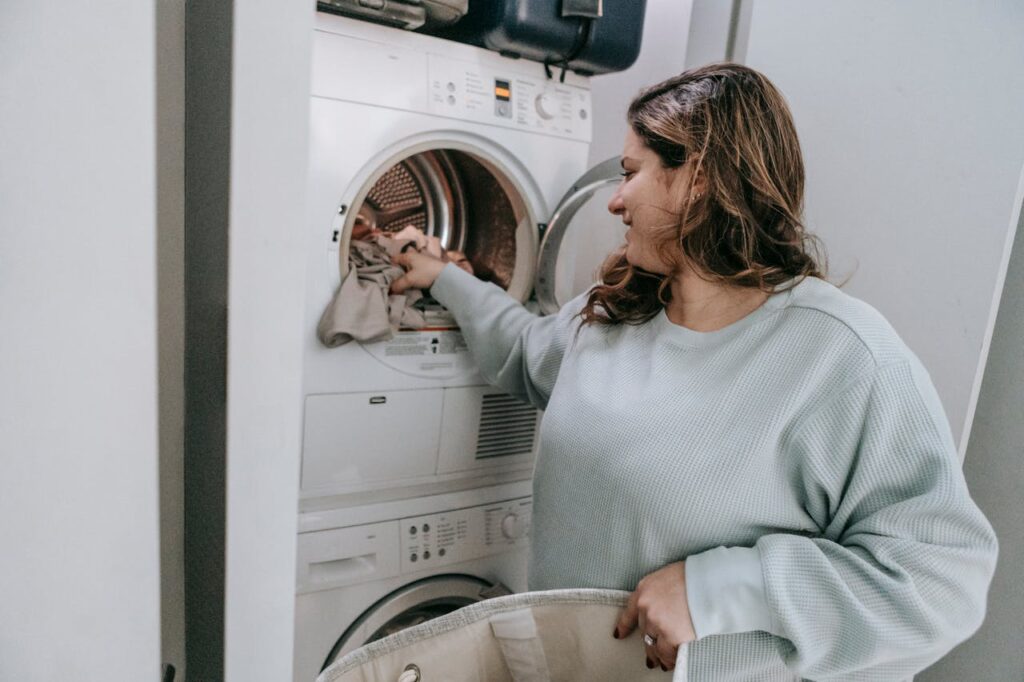
Before you start turning your closet into a laundry nook, it helps to have a clear plan. Each step makes your small space work better and last longer. From measuring the area to choosing the right machines and adding storage, every detail counts.
Let’s break down step by step how to convert a closet into a laundry nook so your it is easy and comfortable to use.
Measure the Closet Space for Washer and Dryer Fit
First, measure the width, depth, and height of your closet. You want to make sure your washer and dryer will fit comfortably inside. If you’re turning a small laundry closet or even a linen closet into a laundry nook, space can be tight.
Measure carefully from wall to wall, and don’t forget to check the floor area for appliance clearance. This helps avoid surprises later.
- Measure width, depth, and height carefully to fit appliances and allow for door clearance.
- Check for extra space needed for hoses, plugs, and airflow around the machines.
- Measure floor level to make sure it’s even for proper machine installation.
- Compare measurements to appliance specs before buying to avoid surprises.
Choose Stackable or Compact Laundry Machines
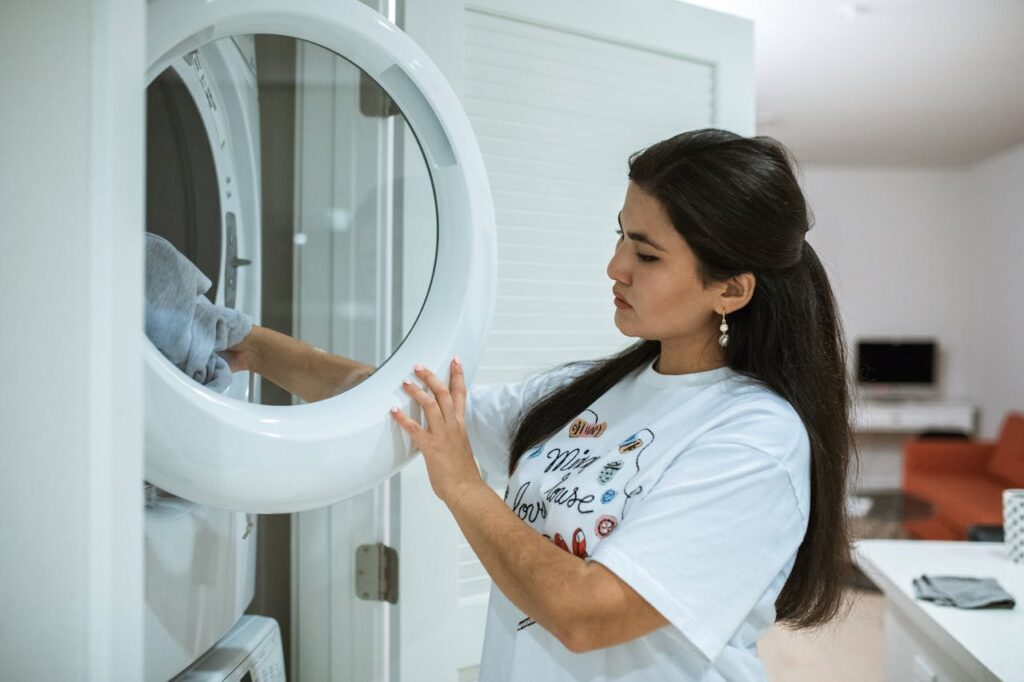
To save space, choose a stackable washer and dryer. These appliances fit one on top of the other, making them perfect for a laundry closet or a small laundry nook.
If your closet is narrow, stackable machines help turn a closet into a functional laundry space without crowding. Some models are even designed for tight areas, so look for “compact” or “small laundry” options.
- Pick stackable washer and dryer models to save floor space.
- Look for compact machines designed for small laundry closets.
- Check the machine’s capacity to make sure it fits your laundry needs.
- Consider energy-efficient models to save power and water.
Ensure Proper Electrical and Plumbing Connections
Your laundry closet needs the right connections to work safely. That means checking or installing electrical outlets and plumbing lines. The washer needs a water supply and a drain, and the dryer needs an electric or gas hookup.
If you’re turning a closet into a laundry room, it’s best to hire a professional to make sure everything is up to code and safe.
- Verify existing outlets meet the power needs of your washer and dryer.
- Arrange for a water supply line and drainage for the washing machine.
- Use a licensed professional to install or upgrade plumbing and electrical safely.
- Check local codes to ensure your setup follows rules.
Install Ventilation for Dryer Exhaust
Dryers produce hot air and moisture that need to leave the space. Proper venting is important to keep your laundry closet fresh and safe. A vent lets the hot air exit outside your home.
Without it, moisture can build up, causing mold or damage. If your closet door seals tight, you might also need a vent or gap to let air flow in, so the dryer works properly.
- Make sure there is a vent leading outside to remove hot air and moisture.
- Use rigid metal ducting for the dryer vent to reduce fire risk.
- Avoid long or twisting vent runs, which reduce dryer efficiency.
- Include an air gap or vent near the closet door for proper airflow.
Add Moisture-Resistant Flooring Inside the Closet
Since water spills can happen, it’s smart to install moisture-resistant flooring in your laundry closet. Materials like vinyl or tile work well because they don’t get damaged by water. Avoid regular carpet or wood floors here.
A good floor keeps your laundry nook clean and protects your home. Plus, it’s easier to mop up spills when they happen!
- Choose materials like vinyl, tile, or sealed concrete that resist water damage.
- Avoid carpet or untreated wood, which can absorb moisture and cause mold.
- Use waterproof sealants on seams or edges for extra protection.
- Consider adding a small drain pan under the washer for leaks.
Use Fold-Back or Sliding Doors for Space-Saving
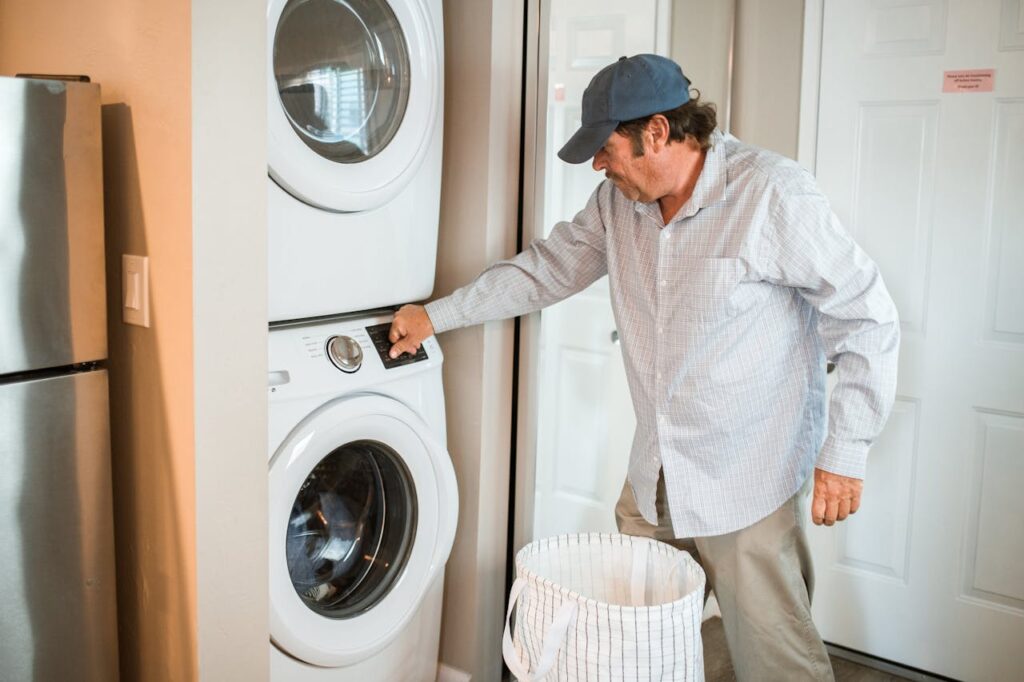
When turning a laundry closet into a laundry nook, choosing the right doors matters. Fold-back or sliding doors save space because they don’t swing out like regular doors. This is helpful if your laundry closet is in a tight spot or on the side of the room.
These doors let you open the closet fully without blocking hallways or counters, making your laundry nook easier to use.
- Install fold-back doors that fold neatly to the side when open.
- Sliding doors glide along a track without swinging into the room.
- Choose doors that match your home’s style for a neat look.
- Make sure door hardware is smooth and easy to operate in tight spaces.
Install Sturdy Shelving Above Machines for Supplies
Adding strong shelves above your washer or dryer gives you great storage for detergent, fabric softeners, and cleaning supplies. A sturdy cabinet or open shelving keeps everything organized and easy to reach.
This shelving makes your small laundry nook more efficient by using vertical space. You can even place a countertop on top of the machines for folding clothes or sorting laundry.
- Use heavy-duty shelves or cabinets to hold detergent, softeners, and cleaning tools.
- Position shelves high enough to clear the washer and dryer tops.
- Add adjustable shelves to customize the space for different items.
- Include small containers or baskets on shelves to keep things tidy.
Add Task Lighting Inside the Closet Area
Good lighting is important when you convert a closet to a laundry space. Task lighting inside the laundry closet helps you see what you’re doing, especially when sorting clothes or reading labels. Install a bright, energy-efficient light that fits inside the closet.
This makes your stylish laundry nook feel brighter and more inviting, even if the closet is small or windowless.
- Install a bright LED light that fits inside the closet space.
- Use battery-powered or plug-in lights if wiring is difficult.
- Position lighting to reduce shadows on counters or machines.
- Consider motion-sensor lights for hands-free convenience.
Use Baskets or Bins for Sorting Laundry
Baskets or bins help keep your laundry organized and tidy. You can use different bins to separate whites, colors, and delicates. Placing them inside or near your laundry closet saves time and effort.
Some people put small bins under a countertop or on shelves for easy sorting. This simple step makes laundry less messy and helps you stay on top of the chore.
- Choose bins with labels like “whites,” “colors,” or “delicates” to organize clothes.
- Place baskets on shelves, under counters, or inside the closet for easy access.
- Use lightweight baskets that are easy to carry to other rooms.
- Clean baskets regularly to avoid odors or mildew buildup.
Seal Gaps to Prevent Moisture Damage
When turning a laundry closet into a laundry room, sealing gaps around the washer or dryer is key. Moisture can escape and cause damage to walls, floors, or nearby cabinets. Use weather stripping or caulk to close small cracks or spaces.
Sealing gaps protects your home and keeps your laundry nook fresh and clean, avoiding problems with mold or water damage.
- Apply weather stripping around closet doors to keep moisture out.
- Use caulk to fill gaps where walls meet floors or around pipes.
- Check seals regularly and replace if worn or cracked.
- Seal gaps to improve energy efficiency and keep the space fresh.
Conclusion
Converting a closet into a laundry nook is a great way to save space and stay organized. With some planning and a few simple changes, you can create a cozy, efficient laundry area right inside your home. Whether you have a small apartment or just want to tidy up your laundry routine, this project can help you do both.
Remember, the key is to use the space wisely and keep things easy to reach. Once your laundry nook is ready, you’ll enjoy the convenience and maybe even find laundry a little less of a chore.
Ready to roll up your sleeves and make it happen? You’ve got this!
FAQs
1. How do I convert a little laundry closet into a functional space?
Start by measuring the available space in the closet. Choose a stackable unit or compact front load washer. Add shelves for bottles of detergent and a hanging bar for clothes. Use fold-back doors to save space.
2. What type of washer fits best in a small laundry nook?
A front load or stackable unit fits best in tight spaces. They save space and offer counter space on top if paired with a pedestal drawer.
3. How can I add a drying rack inside my laundry nook?
Install a fold-down drying rack or use a hanging bar in the closet side. These allow you to hang clothes to dry without taking up floor space.
4. Should I hire an electrician or plumber to set up my laundry nook?
Yes. An electrician can ensure the washer and dryer hook-up is safe, while a plumber handles water and drain lines. This makes sure everything meets safety standards.
5. How much counter space do I need in a laundry nook?
Aim for at least 2 feet of counter space for folding and sorting. You can create this by adding a countertop above a stackable washer or a pedestal drawer.
6. Can I use a standard door for my laundry nook?
Yes, but louvered or fold-back doors are better for ventilation and saving space. Louvered doors allow airflow, reducing lint and moisture build-up.
7. How do I make enough space for an ironing board in a laundry nook?
Choose a slim, wall-mounted ironing board or one that folds behind the closet door. Hooks or extra hangers can store it neatly.
8. Where should I place hooks or hangers in the laundry nook?
Install a hanging bar or hooks on the closet side or back wall. This creates a place to hang clothes right after washing or for drying.
9. How do I keep lint from building up in a small laundry closet?
Clean the lint trap after every load. Also, make sure the dryer vent is clear and properly vented outside to prevent lint buildup in the space.
10. Can I turn a linen closet into a laundry nook?
Yes, if it has enough space and proper hook-up for water and electricity. You may need a plumber and electrician to help with connections.
11. What storage space should I add to a laundry nook?
Add cabinets or shelves above the washer and dryer. Use drawers or bins to store laundry supplies like bottles of detergent, fabric softener, and stain removers.
12. How do I prevent water drip damage in my laundry nook?
Install moisture-resistant flooring and a drip pan under the washer. Seal gaps around pipes and the floor to stop water damage.
13. How do I turn open space in a closet into useful laundry storage?
Use stackable units to free floor space. Add a hanging bar for drying clothes and shelves or drawers for supplies to maximize storage.
14. What laundry tips help keep my nook organized?
Label bins for sorting laundry. Use baskets to separate whites and colors. Keep extra hangers handy and clean the lint filter regularly.
15. Can I find supplies to convert my closet into a laundry nook at Home Depot?
Yes! Home Depot offers appliances, shelving, fold-back doors, drying racks, and lighting options perfect for your new closet laundry nook.

